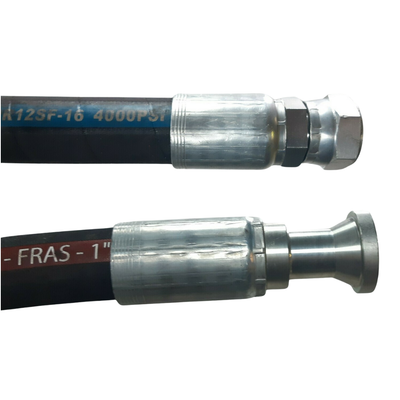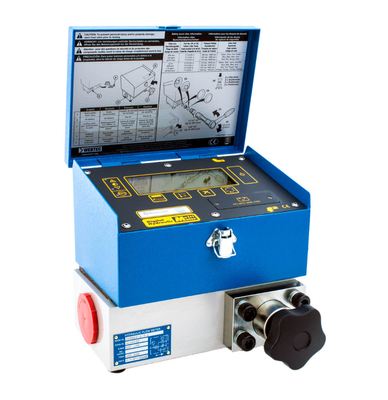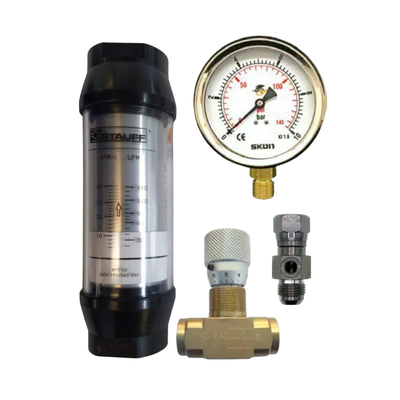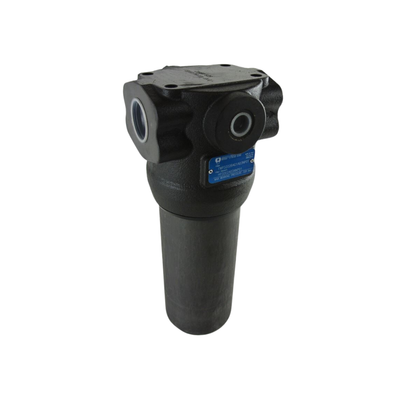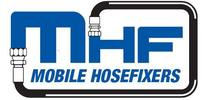
Hydraulic Inline Flow Meter & Pressure Test Kit 120 Lt/Min 420 bar
Flow and Pressure test Kit Using a STAUFF Inline Hydraulic Flow Meter for Performance testing and Trouble Shooting of Hydraulic Circuits.
Measures Oil flows up to 120 Lt/min: and Pressures to 420 bar (6,000 PSI)
Available in two models:
- Standard One Way Flow or
- Bi-Directional Reversable Flow
Both model of flow kit come Complete with: a broad range of
- BSP, JIC, ORFS, and Sae Code 61 adaptors and
- Two x 2 metre Long 3/4" bore Test hoses.
- Standard supply of SAE 100R2 @ 3,200 psi,
- Optional SAE 100R19 @ 4,000 psi (at additional cost)
- Optional SAE 100R15 @ 6,000 psi. (at additional cost)
An Inline Hydraulic Flow Meter manufactured by Stauff Germany.
Kit designed and assembled in Australia by trained hydraulic fitters.
- Test hydraulic oil flows in any circuit with flows up to 120 Liters per minute and pressures up to 6,000 PSI (420 bar)
- The latest upgrade: takes the basic "Stauff" Single Direction Inline Hydraulic Flow Meter and makes it Bi Directional with the addition of Four (4) simple inline flow check valves and adaptors and a compact Oil Flow Design.
This upgrade is awesome value for money: and is well worth it for the additional flexibility and versatility it provides in testing Reversable Flow Piston Pumps and Hydrostatic Transmissions.
The kit comes complete with two (2) 2 meter long high pressure hoses and 18 different adaptors (BSP, JIC, ORFS, SAE code 61) that allow you to connect to:
- BSP threads from 1/4" to 3/4 ",
- JIC threads from 9/16" to 1-1/16"
- ORFS Threads from 9/16 to 1-3/16"
- SAE Code 61 Flange 3/4
Full operating instructions and worked examples are also provided.
Assembled from quality components this kit is designed to measure the following.
- Oil Flows up to 120 litres per minute or (30 US Gallons/Min)
- Induce and measure pressures up to 420 Bar (6,000 PSI).
- 1 x "Stauff" Hydraulic Flow Indicator, manufactured by Webtech UK.
- This flow test kit is designed to accurately test low to medium flow hydraulic circuits such as those found in factories and mobile equipment up to 12 tons such as;
- Tractors
- Street sweepers,
- Concrete agitators,
- Tippers,
- Tow trucks
- Skid Steers, Posi track earth movers,
- Excavators,
- Front end Loaders,
- Tilt trays, Scissor lifts
- Forklifts and
- most hydraulic circuits with flows of 120 Liters per minute or less.
- Induce Pressures and measure pressures up to 420 Bar (6000 PSI).
- Induce Pressures and measure pressures up to 420 Bar (6000 PSI).
- A Steel Flow Control Valve and rated to 350 BAR (5150 PSI).
- With 3/4" BSPP ports, large easy to turn manual adjustment handle and a visual indicator of valve position.
- A pair of Test Hoses each 2 meters long and having a 3/4" Inside diameter
Pressure Ratings Starting at Standard supply of 3,200 psi and optional test hoses of 4,000 psi and 6,000 psi. - Eighteen (18) Assorted JIC, BSP and ORFS adaptors to be able to virtually connect and flow test any piece of machinery.
Why pay $5,000 or more when you can have it all delivered to your door from $2,575
The main Components of the test kit include the following.
A WEBTEC / STAUFF Inline Hydraulic Flow Meter with Dial Indicator and built in thermometer, manufactured by Webtech England for Stauff Germany, it has the following features.
· Flows up to 120 Litres per minute (30 US Gallons per minute)
· Pressures up to 420 Bar (6000 PSI)
· Accuracy 4% of full scale
· 3/4" BSPP Ports
· No batteries required.
· A 400 Bar (6,000 PSI) Liquid Filled Stainless Steel Pressure Gauge
· Flow meter manufactured from Full Aviation grade Aluminium.
The Entire test kit is mounted in a Heavy Duty Black plastic case with carry handle.
A flow test kit is the quickest and least invasive way to quickly check for internal leakage of a suspected component in a hydraulic circuit be it a valve, motor or pump.
A flow test kit can also be used to ascertain if the engine or motor powering the hydraulic system is in good condition and or even capable of powering the hydraulic systems requirements.
Hydraulic pumps, directional control valves, relief valves and cylinders in a hydraulic circuit can be individually checked for internal leakage.
Principle of operation.
The flow test kit is added into the hydraulic circuit and is connected as close as possible before or after the suspected component.
Using a relatively easy process of recorded measurements, logic and simple elimination each component can be individually tested and results compared to the performance of the rest of the hydraulic circuit.
The process described below is used for testing a hydraulic pump.
The flow test kit is installed as close as possible to the pump's pressure port.
The pump is started and allowed to free flow without load. Flow, and temperature are recorded at free flow.
The flow control valve is then slowly closed to induce a resistance to flow and any changes to flow, pressure and temperature are recorded (usually at 500 PSI intervals) this test is usually carried out up to the pump's maximum manufacturers recommended pressure.
Results are then compared to manufacturer's data to ascertain any loss in performance.Contact us on +617 5563 1982 with any questions or special adaptor requests.
Allow 4 - 8 Business days for assembly and dispatch
REVERSE FLOW KIT
Typical usage;
A flow meter & pressure gauge are crucial components to check the health of your hydraulic pump or motors. When a hydraulic powered machine presents you with issues such as power loss or speed loss, using a flow meter is the only way to establish where the problem is.
Hydraulic pumps & motors are very susceptible to contaminants & dirt causing wear in unmaintained circuits. If a hydraulic pump or motor is exposed to dirt etc. in the oil, or even cavitation or aeration, (air in system) the tolerances blow out very rapidly. This loss of tolerances means that normal high pressures are no longer achievable as oil simply slips past surfaces from wear.
Often hydraulic machines, ie excavators, skid steers present with loss of power to either wheel motors or lifting power to cylinders is poor. First step to check issue should be a flow test. It is good to find hydraulic specs online to find what Flow in Lt/min the machine's pump should be producing.
Steps to follow to produce Accurate results.
Always wear safety glasses, gloves etc. High pressure oil injection can result in amputation & nasty injuries!
Have a pen & clip board to notarise numbers at certain pressure readings. ie make a sheet with zero , 500, 1000, 1500, 2000, 2500psi etc columns ready.
To test a hydraulic pump first step is to attach the flow meter to the pumps pressure line.
There must also be an exit hose either back to tank, or however suits to return oil from the other end of the flow meter.
The oil flow from pump must go in direction of flow meter's arrow (load sense pumps are excluded).
On our reverse flow kits, you can use either connection, it won't matter.
Ensure the needle valve is fully open(clockwise) before starting your hydraulic pump.
Set machine to correct RPM range for normal usage, remember fixed displacement pumps flow more/less depending on engine RPM.
You can then write down the first reading in LPM from the flow meter on the sheet of paper. ie. 70LPM @ zero Psi.
Then to mimic putting a heavy load on the pump, which is when oil would want to start 'slipping/bypassing, start turning the needle valve CW until you see pressure gauge rising.
Stop at say, 500 psi intervals & again note down the LPM flow @ 500psi.
Then adjust again in approx. another 500 Psi increments noting Lpm flow readings.
Gear pumps have a normal 20% bypass slippage rate from new, piston pumps have less.
You will notice your Lpm flow rate number decreasing as pressure increases.
If flow drops more than 20% below zero pressure flow rate, the pump has wear.
In this case, where the pump had 70Lpm @ zero,
it should still flow 52 Lpm at higher pressures if in good condition.
To test hydraulic motors, set up is similar. However a case drain hose back to tank MUST be fitted. Again you will need to find manufacturers specs on expected leakage rates.
IMPROPER SELECTION, INSTALLATION, IMPLEMENTATION AND/OR OPERATION BY ANYONE OTHER THAN PERSONS WITH APPROPRIATE TECHNICAL AND MECHANICAL TRAINING CAN RESULT IN DAMAGE TO EQUIPMENT OR PROPERTY, SERIOUS PERSONAL INJURY OR DEATH. PROPER PRECAUTIONS AND SAFETY PROCEDURES SHOULD BE IMPLEMENTED PRIOR TO INSTALLATION AND OPERATION OF EQUIPMENT.
MM 11/12/2024 $, Pic, Hose Options, Alt text
BI-DIR PO-36842, 36841, 36832




